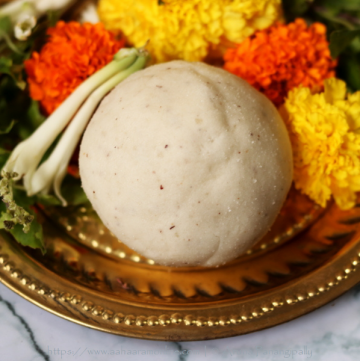Pachi Chalimidi is a vastly underrated Andhra dish that can be loosely defined as a rice flour laddu. It needs virtually no cooking and hence the word “Pachi” in its name. Pachi means raw in Telugu.
Chalimidi is one of those traditional Andhra sweets that is made on almost all auspicious occasions. It is a must on festivals such as Sri Rama Navami, Nagula Chavithi, Sharada Navaratri, and Varalakshmi Pooja. It is also given to a bride to carry to her husband’s home when she goes there the first time and to a pregnant lady at Seemantham (baby shower).
As I was getting ready for naivedyam for the 9-days of Navratri, I realised that I had not written about this simple yet important sweet.
Chalimidi can be made in two ways: Pachi Chalimidi (raw) or Pakam Chalimidi (in a syrup). In this post, I am writing about the former as it is easier to make.
My fellow blogger Srividhya of Vidhya’s Vegetarian Kitchen commented on my post that this particular dish was made in Karnataka as well and was called thembittu there. A bit of search on the internet revealed that this was indeed so and that there were other variations of it made with gram flour and wheat flout as well. The version made with rice flour is called Akki Thambittu.
Thanks, Srividhya for this. 🙂
I had first posted this recipe in September 2014 and have updated it to include a recipe card.
Recipe for Pachi Chalimidi or Akki Thambittu
Pachi Chalimidi Or Akki Thambittu
Equipment
- Bowl
Ingredients
- 1 Cup Rice Flour
- 3/4 Cup Powdered Sugar
- 3 tbsp Grated Coconut
- 1/4 tsp Cardamom Powder
- 3 to 4 tbsp Ghee
Instructions
- To a bowl, add the 1 cup rice flour, 3 tbsp grated coconut, 3/4 cup powdered sugar, and 1/2 tsp cardamom powder.
- Mix well.
- Melt 4 tbsp ghee.
- Gradually add the melted ghee to rice flour mix.
- Mix well. You should have a wettish mix that can still be shaped into a soft ball.
- Shape the Pachi Chalimidi into a large ball or into small laddus.
- Offer as naivedyam along with Panakam and Vada Pappu.
Notes
- You can also make Chalimidi with Grated Jaggery. In this case, grate the jaggery till it is very fine and then add hot ghee to jaggery to melt it. Then add the rest of the ingredients and mix well.
- You can use small pieces of coconut instead of coconut. If you are doing that fry the pieces in the heated ghee till they just start to change color.
- I have used both store-bought and home-made rice flour with equally good results. Now-a-days, I stick to store-bought flour as I rarely have the time to make rice flour afresh.


Great.. we do this too. In kannada we say thembittu
Hi Vidhya,
Thank you for the tip. Updated the post with due credit to you. 🙂
:-).. love this dish
I wish you had a like button!
Oh wait, I finally found it; you *do* have a like button! Hurray!
🙂 🙂
Wow Aruna, this looks really nice… 🙂
What a simple and easy recipe.
I am gearing up for navratri too. Will be focusing on detoxing. Have a great holiday Aruna.
Navratri in South India is replete with food!
🙂
We do something similar called maavilaku.:-) i love this
Thambittu is what we call it as and looks lip smacking…. back to my childhood days where my granny used to make this during festive seasons…. nostalgia. .
As Vidya mentioned in Tamil Nadu it is called Maavilakku and they shape it like an oil lamp. It is lit in front of the deity with ghee and a cotton wick to burn. After the puja it is eaten and tastes yummy with a film of ghee and a chared corner. Reminds me of all the occasions I have devoured it.
V do something similar in Tamil nadu called maavilakku:-)
rice flour is not cooked? is that okay to eat raw rice flour? Thanks!
Yes, perfectly OK to eat it this way.